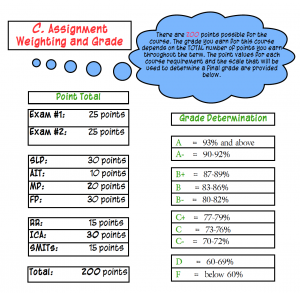Evaluation System and Grading Scale
 Instructors assign grades on the basis of their evaluation of the academic performance of each student enrolled in their courses. Course grades are based on the quality of the student’s performance as evaluated by the performance criteria stated in the course syllabus.
Instructors assign grades on the basis of their evaluation of the academic performance of each student enrolled in their courses. Course grades are based on the quality of the student’s performance as evaluated by the performance criteria stated in the course syllabus.
At the first scheduled class meeting, the instructor must state the basic requirements and assignments of the course and indicate his or her method of evaluation.
- Undergraduate Courses – Plus/Minus Grade points for an undergraduate course are computed by multiplying the number of semester-hour credits by the numerical values assigned to the letter grade received.
- Graduate Courses – Grades consist of: A (Excellent), B (Good), C (Passed), F (Failure)
See Faculty Manual statements about grades and grading (Faculty Manual, Part 6, Section 1, VIII):
http://www.ecu.edu/cs-acad/fsonline/customcf/currentfacultymanual/part6section1.pdf
Note the ECU Faculty Manual policy on Academic Progress:
IX. Academic Progress
“Instructors should ensure that each student has received some indication of his or her standing in the course prior to the last day to drop a course without grades. While it is understood that the procedures used to measure course objectives may differ between disciplines, instructors, particularly those of 1000- and 2000-level courses, should provide their students with the results of some form of graded response (e.g., tests, term papers) prior to the last day to drop. A student should be able to discuss progress in class with the instructor any time in the semester.
Faculty members must report to the appropriate university office the unsatisfactory standing of first year undergraduate students whose work or attendance is poor at the middle of the semester. Instructions for reporting unsatisfactory progress are sent via email each semester to the faculty. (FS Resolution #10-08, February 2010)” (East Carolina University Faculty Manual Part VI, 2020)
Explore multiple methods for depicting grading scales.
While being clear and fully explaining how student grades will be determined is the priority, some students also find a visual image of the grade distribution helpful to determine the weights of course assignments and activities. Below are some examples of elements faculty include as a part of an explanation of evaluation systems and grading scales.

________________________________________________________________________________

________________________________________________________________________________

From Ann Spuches’ General Chemistry course syllabus
________________________________________________________________________________

________________________________________________________________________________
